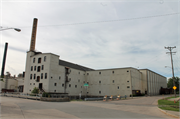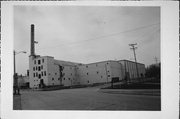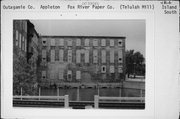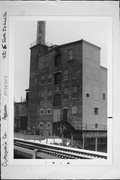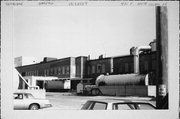Property Record
601 S VULCAN ST
Architecture and History Inventory
| Historic Name: | Telulah Paper Mill |
|---|---|
| Other Name: | FOX RIVER PAPER CO. |
| Contributing: | Yes |
| Reference Number: | 38959 |
| Location (Address): | 601 S VULCAN ST |
|---|---|
| County: | Outagamie |
| City: | Appleton |
| Township/Village: | |
| Unincorporated Community: | |
| Town: | |
| Range: | |
| Direction: | |
| Section: | |
| Quarter Section: | |
| Quarter/Quarter Section: |
| Year Built: | 1887 |
|---|---|
| Additions: | 1920C. 1940 |
| Survey Date: | 20012019 |
| Historic Use: | mill |
| Architectural Style: | Astylistic Utilitarian Building |
| Structural System: | Concrete Beam |
| Wall Material: | Brick |
| Architect: | Thomas O'keefe |
| Other Buildings On Site: | Y |
| Demolished?: | No |
| Demolished Date: |
| National/State Register Listing Name: | Not listed |
|---|---|
| National Register Listing Date: | |
| State Register Listing Date: |
| Additional Information: | A 'site file' exists for this property. It contains additional information such as correspondence, newspaper clippings, or historical information. It is a public record and may be viewed in person at the Wisconsin Historical Society, Division of Historic Preservation-Public History. Resurveyed December 2010; no visible changes. Fox River Valley Industrial Survey The Kimberly-Clark Company was founded in 1872 by John Kimberly, Charles Clark, Havilah Babcock, and Frank Shattuck. The company, located in Neenah, first made newsprint exclusively, but soon added book paper and wrapping paper to their products. Kimberly-Clark made much of their paper entirely out of rags and linen, rather than wood pulp, and were the first mill in Wisconsin to use these materials extensively. The company expanded quickly, purchasing the rival Neenah Paper Mill in 1874 and then expanding their first site at the non-extant Globe Mill in Neenah in 1876. The company constructed the Atlas Mill in Appleton the Badger Mill in Neenah in 1878. In 1887, Kimberly-Clark established the Telulah Mill at 430 East South Island Street in Appleton. The mill was devoted to a diverse line of specialty paper products, such as colored book pages, and training and experimenting for young managers and engineers. By 1897, Kimberly-Clark, the largest paper company in the state, had expanded beyond the Fox River Valley into northern Wisconsin and the Upper Peninsula of Michigan. Demand for large quantities of refined, bleached, groundwood paper during World War I convinced management to switch production at the Telulah Mill in that direction. In 1920, Kimberly-Clark sold the large mill to the rival Fox River Paper Company, which had four nearby mills along the north side of Fox River. The mill was remodeled and repurposed to produce large quantities of writing paper, a transition that had already begun under the ownership of Kimberly-Clark. Production increased to 50 tons of paper a day, and the mill became the largest producer of bond paper in the nation until the 1940s. The non-extant Patton Mill to the north, adjacent to the Telulah Paper Mill, was also purchased by the Fox River Paper Company and converted into an associated warehouse. The Telulah Paper Mill consistently had over 500 employees during the 1920s through the 1940s. The mill itself is oriented along an east-west axis with the machinery placed over the tail race at the eastern end of the building. A warehouse addition to the north and an expansion to the south were completed in the early 1920s, likely as a part of the Fox River Paper Company’s renovation of the building. Rows of windows can be seen along each of the three floors on all sides of the large painted brick building. The paper making machines were located at the eastern end of the building, shafting, papermaking, and materials were located along the long section to the west. A machine shop and power plant were located to the south, and storage was located on the upper floors and in a warehouse addition to the north. The Fox River Paper Company, owned by W. C. Wing, became a corporation in 1938 and consolidated much of its specialty production at the Telulah Mill in 1940 while closing some of their smaller mills in Appleton. The same year, a small, art deco, brick office was constructed opposite the mill. Consolidation continued as the Fox River Paper Company closed its other mills nearby from 1948 to 1955. The Telulah Paper Mill continued to operate through the 1980s. The Telulah Paper Mill is significant under Criterion A: History in the area of Industry for its role in the Appleton paper industry. The period of significance for the property would extend from 1887 to circa 1970. The mill is also potentially eligible for listing in the National Register under Criterion A: History in the area of Industry as a contributing resource to the South Island Industrial Historic District for its role in the history of the paper industry. The period of significance for the district would extend from 1887 to 1940. |
|---|---|
| Bibliographic References: | (A.) THE FIRST 25 YEARS, Cooperation 1872-1947, 75th Anniversary Issue; Fox River Paper Company, p. 8. (B.) THE SECOND 25 YEARS, ibid. p. 12. (C.) "The Fox River Paper Company," POST CRESCENT, 04/23/1928. (D.) "Fox River Paper Plans $2 Million Expansion," POST CRESCENT, 01/09/1979, Section B, p. 1. |
| Wisconsin Architecture and History Inventory, State Historic Preservation Office, Wisconsin Historical Society, Madison, Wisconsin |

